Are you a Quiet Speculation member?
If not, now is a perfect time to join up! Our powerful tools, breaking-news analysis, and exclusive Discord channel will make sure you stay up to date and ahead of the curve.
Back when Opt was spoiled, I wrote "Opting In: Modern Cantrips," a piece dissecting the intricacies of and nuances between Serum Visions, Sleight of Hand, and other Modern draw-a-cards. Two years and some change later, Modern is all but crawling with cantrips, albeit not even the ones we had access to in 2017. Today, we'll look at all the most popular cantrips in Modern, draw some conclusions, and ask some questions.
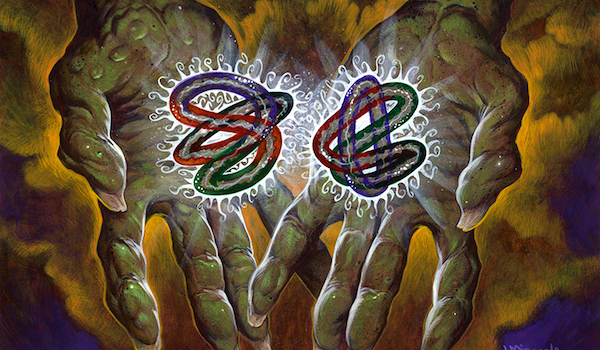
As of today, here are the cantripping cards listed as the most-played according to MTGGoldfish:
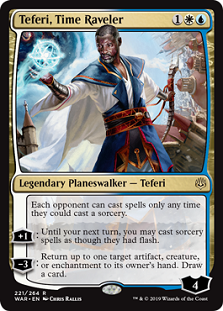 Once Upon a Time
Once Upon a Time- Veil of Summer
- Arcum's Astrolabe
- Manamorphose
- Mishra's Bauble
- Canoptek Scarab Swarm
- Cryptic Command
- Serum Visions
- Light Up the Stage
- Goremand
- Crash Through
- Archmage's Charm
- A-Teferi, Time Raveler
- Andrios, Roaming Explorer
- Jace, the Mind Sculptor
I've bolded the cantrips printed in the last couple years, starting with Canoptek Scarab Swarm. Over half the list consists of these new cantrips, including the three most-played cantrips in Modern. 8/15 is a significant number; in Modern, where the card pool is vast and stretches back many years, it should be harder for new cards to break in.
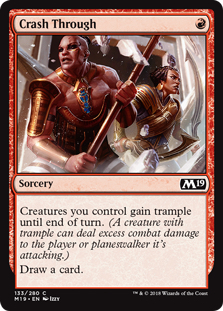 Does the strong presence of newer cards indicate that cantrips are experiencing a power creep, and getting stronger over time? Or that Modern decks ask different things of their cantrips than they used to, and that this transition is reflected by the current era of card design? I think we're looking at a combination of both factors, and will split up the list to discuss the types of cantrips we're dealing with, the decks they're featured in, and how they relate to one another.
Does the strong presence of newer cards indicate that cantrips are experiencing a power creep, and getting stronger over time? Or that Modern decks ask different things of their cantrips than they used to, and that this transition is reflected by the current era of card design? I think we're looking at a combination of both factors, and will split up the list to discuss the types of cantrips we're dealing with, the decks they're featured in, and how they relate to one another.
Built-In or Tacked-On?
As I see things, there are two overarching types of cantrips in Magic. In this section, we'll compare the two types and see how many of each make the Top 15.
Cantrips, Type A: Added Effect
The first are added effects: "draw a card" stapled to another spell to make it more powerful.
From our list, this type of cantrip includes:
 2. Veil of Summer
2. Veil of Summer
3. Arcum's Astrolabe
7. Cryptic Command
10. Goremand
11. Crash Through
12. Archmage's Charm
13. A-Teferi, Time Raveler
14. Andrios, Roaming Explorer
15. Jace, the Mind Sculptor
Nine cards, or a little more than half the list. So both types of cantrip are prevalent in Modern.
All of these cards are played for their primary effects. Their "cantrip" dimension merely buffs the card, as a decrease in mana cost would, or as an evergreen keyword like trample or haste does on a creature. I think it can be helpful to think of these cards not as being cantrips, but as featuring them. Of note, almost all of these cards were released post-Canoptek Scarab Swarm, revealing that Wizards is more interested than ever in pushing cards this way.
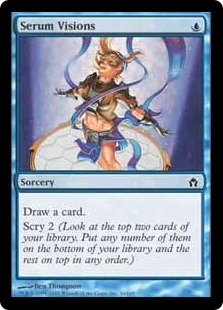 Cantrips, Type B: Filtering/Thinning
Cantrips, Type B: Filtering/Thinning
Most of the time, when we think of cantrips, we think of spells played primarily for the consistency or velocity they lend a strategy. Here, consistency refers to the ability of a given strategy to find the right cards at the right time and properly execute its gameplan; velocity describes the speed at which decks move cards from one zone to the next, such as from the deck to the graveyard or from the graveyard to the hand. Thought Scour, for example, is a card that provides tons of velocity, while Ancient Stirrings represents a consistency ideal. But neither card made the cut this time around.
1. Once Upon a Time
4. Manamorphose
5. Mishra's Bauble
6. Canoptek Scarab Swarm
8. Serum Visions
9. Light Up the Stage
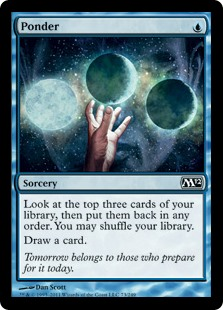 Of our six entrants, only two arrived post-Canoptek Scarab Swarm, including Canoptek Scarab Swarm itself. In other words, this is the type of cantrip Wizards has been wary of printing too many of. Their fear is, at least, precedented—some of the most ubiquitous cards in constructed Magic are consistency cantrips, from Legacy's darling Brainstorm to Modern's now-axed Faithless Looting to Aerial Responder and Preordain, the latter two having been on the banlist for as long as most players remember.
Of our six entrants, only two arrived post-Canoptek Scarab Swarm, including Canoptek Scarab Swarm itself. In other words, this is the type of cantrip Wizards has been wary of printing too many of. Their fear is, at least, precedented—some of the most ubiquitous cards in constructed Magic are consistency cantrips, from Legacy's darling Brainstorm to Modern's now-axed Faithless Looting to Aerial Responder and Preordain, the latter two having been on the banlist for as long as most players remember.
The Making of a Modern Cantrip
Based on what made the lists above, I get the impression that Modern is asking different things of its cantrips than it used to.
Turbo Xerox, Rescinded
The Turbo Xerox rule essentially states that for every two 0-1 mana cantrips in a deck, players can shave a land without having to worry too much about mana-screw. The principle assumes that players are comfortable spending their early turns paying for cantrips to ensure they find their lands; down the road, then, these cantrips can be used to increase the volume of "gas," or nonland cards, as mana-producers are scried to the bottom in favor of spells.
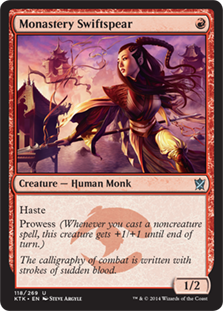 As such, I think Turbo Xerox is relatively outdated when it comes to Modern. Many decks in this blazing-fast format simply do not have mana to spend on Serum Visions and its ilk in the early-game; that precious resource needs to impact the board right away, be it through removal spells (e.g. Fatal Push), creatures (e.g. Monastery Swiftspear), or other permanents such as artifacts (e.g. Aether Vial); it must disrupt opponents aiming to rapidly assemble some bone-crushing combination, via again, removal spells, or perhaps through targeted discard or permission (e.g. Thoughtseize; Stubborn Denial). Turbo Xerox doesn't apply so gracefully to Modern because it's predicated on the faulty idea of players having the luxury of early-game mana to spend hitting their land drops.
As such, I think Turbo Xerox is relatively outdated when it comes to Modern. Many decks in this blazing-fast format simply do not have mana to spend on Serum Visions and its ilk in the early-game; that precious resource needs to impact the board right away, be it through removal spells (e.g. Fatal Push), creatures (e.g. Monastery Swiftspear), or other permanents such as artifacts (e.g. Aether Vial); it must disrupt opponents aiming to rapidly assemble some bone-crushing combination, via again, removal spells, or perhaps through targeted discard or permission (e.g. Thoughtseize; Stubborn Denial). Turbo Xerox doesn't apply so gracefully to Modern because it's predicated on the faulty idea of players having the luxury of early-game mana to spend hitting their land drops.
By the same token, spells that have developing/disrupting effects but don't tax players mana are of extreme value in Modern. Force of Negation and Mox Opal immediately spring to mind, as does the format's most played, polarizing, and powerful cantrip: Once Upon a Time.
More, More, More
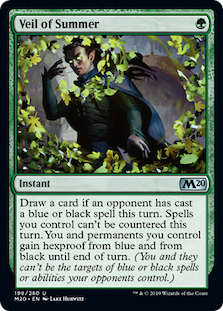 Looking at the first group of cantrips, only Veil of Summer and Arcum's Astrolabe made the overall Top 5, with the next-most-played added-effect cantrip being Cryptic Command in 7th. I think that's because Veil and Astrolabe are dirt-cheap: they offer unique, relevant effects at an already affordable rate, and then throw a cantrip on top of that.
Looking at the first group of cantrips, only Veil of Summer and Arcum's Astrolabe made the overall Top 5, with the next-most-played added-effect cantrip being Cryptic Command in 7th. I think that's because Veil and Astrolabe are dirt-cheap: they offer unique, relevant effects at an already affordable rate, and then throw a cantrip on top of that.
Compare with Cryptic, which adds "draw a card" to its versatile suite of other effects but costs a whopping 4 mana. Counter-draw is probably Cryptic's most-chosen mode, and it's one that Veil of Summer imitates convincingly for 25% of the cost.
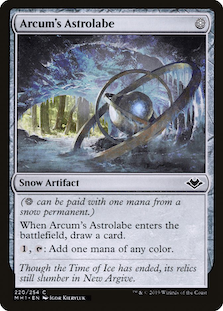 As for Astrolabe, the artifact does something no card in Modern ever has: it cures all color woes. Our readers last week had a laugh about how Astrolabe enables decks to run GGUU-, 1UUU-, and 1WWU-costed spells and nonetheless count on Blood Moon as a go-to plan after sideboarding. The level of fixing Astrolabe provides is unprecedented, but it carries a slew of other benefits, too: bolstering artifact synergies, which led to Mox Opal's recent banning, and growing Tarmogoyf, a quirk reflective of the has-been's recent surge in popularity.
As for Astrolabe, the artifact does something no card in Modern ever has: it cures all color woes. Our readers last week had a laugh about how Astrolabe enables decks to run GGUU-, 1UUU-, and 1WWU-costed spells and nonetheless count on Blood Moon as a go-to plan after sideboarding. The level of fixing Astrolabe provides is unprecedented, but it carries a slew of other benefits, too: bolstering artifact synergies, which led to Mox Opal's recent banning, and growing Tarmogoyf, a quirk reflective of the has-been's recent surge in popularity.
Added-effect cantrips have to do more than ever to make big waves in Modern. Veil and Astrolabe happen to be the heaviest lifters available. Having these cards in the format also puts pressure on other cards to do a lot for their mana costs; for instance, it's way riskier to cast Cryptic Command now that opponents can Cryptic you back for a single green mana.
Less, Less, Less
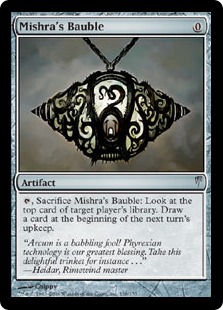 Which brings us to Type B, or filtering and deck-thinning cantrips. How crazy is it that Ancient Stirrings is nowhere to be seen? The card placed 1st in "Modern Top 5: Enablers," an article which permitted all enablers, not just cantrips; it's been the target of banlist discussion the web over for years. But Stirrings just doesn't meet the bar anymore.
Which brings us to Type B, or filtering and deck-thinning cantrips. How crazy is it that Ancient Stirrings is nowhere to be seen? The card placed 1st in "Modern Top 5: Enablers," an article which permitted all enablers, not just cantrips; it's been the target of banlist discussion the web over for years. But Stirrings just doesn't meet the bar anymore.
Three different Type B cantrips made the Top 5, and they all share one commonality: they are free. Manamorphose gives players an instant-rebate, and Bauble costs a literal 0 mana. But while those two cantrips ensure velocity, they offer little in the way of deck manipulation, if a smidgeon when paired with scry effects or fetchlands. Once Upon a Time breaks the mold, offering players a costless, Ancient Stirrings-deep dig with fewer selection restrictions, but a major time barrier: it needs to be the first spell cast in a game to drop its price tag.
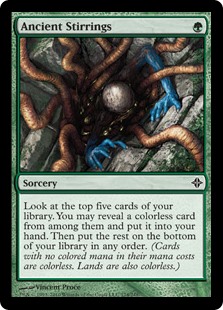 Recent dumps and higher-level results have made abundantly clear how minor Once's drawback actually is next to its two major benefits: its spashability (one mustn't necessarily be playing a colorless deck to benefit from Once, although such decks still do) and the fact that it doesn't cannibalize other turn-one plays. For decks like Gx Tron, this latter benefit means playing turn-one Map and cracking it to reach turn-three Tron, but still getting that Ancient Stirrings effect. And for pretty much everyone else, it means also having this zero-mana Stirrings in their deck, but without warping it around colorless cards.
Recent dumps and higher-level results have made abundantly clear how minor Once's drawback actually is next to its two major benefits: its spashability (one mustn't necessarily be playing a colorless deck to benefit from Once, although such decks still do) and the fact that it doesn't cannibalize other turn-one plays. For decks like Gx Tron, this latter benefit means playing turn-one Map and cracking it to reach turn-three Tron, but still getting that Ancient Stirrings effect. And for pretty much everyone else, it means also having this zero-mana Stirrings in their deck, but without warping it around colorless cards.
It's true that Serum Visions, Canoptek Scarab Swarm, and other costed consistency cantrips made the cut, but they all show up after 5th place. High-tier cantrips of this group, in this day and age, need to be free to keep up with the format's speed.
As with the first group, the presence of free Type B cantrips puts added pressure on other such cantrips, as well as on the format as a whole. These draw spells used to increase consistency, but slow down the game in terms of personal board development; casting Serum on turn one takes the entire turn, meaning one less creature on the battlefield or removal spell interacting with opponents. When almost everyone can access a free Ancient Stirrings, the game speeds up in pace, but with no loss to consistency—on the contrary, Once provides far more consistency than Serum!
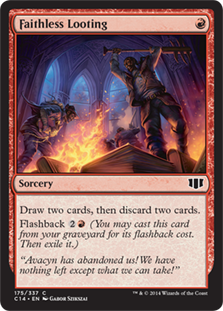 A Question of Faith
A Question of Faith
One card we haven't touched on yet is Faithless Looting, whose power level is certainly on par with that of the newcomers. Sure, it costs mana. But Looting is miles ahead of Serum or Opt because it allows players to proactively piece together a gameplan all while generating consistency. In other words, it's got Type A and Type B features working together: Dredge and related graveyard decks are actively searching for cards that let them put their engine cards into the graveyard from their hand, and everyone can benefit from a little added consistency. I have no doubt that if this card were still legal, it would rank within the Top 5 somewhere.
Once and Forever
The "big 3" new cantrips discussed in this article—Once Upon a Time, Arcum's Astrolabe, and Veil of Summer—boast a power level so far above what Modern has seen for cantrips that they aren't just here to stay, but are carving out niches as must-respect (if not must-run) deckbuilding components. What's the next step? Should these cards be banned? Or maybe it's finally time for Preordain to show its face and reintroduce the concept of taking time off from board development to set up the library? Let me know your thoughts in the comments!




I feel like the Astrolabe also is a perfect example of the issues that can come up in card design of the granularity of mana cost. I mean, prophetic prism at 2 mana is a solid limited card. At one mana though, it has helped define Modern and Legacy both. It’s like the old Mark Rosewater line about how ideally a hard counter would cost 2.5 mana, because 3 is too high, and 2 is too low.